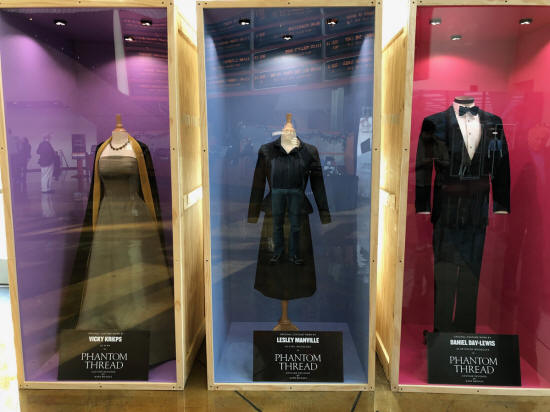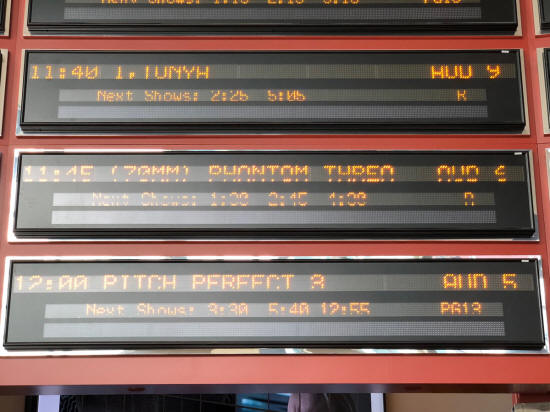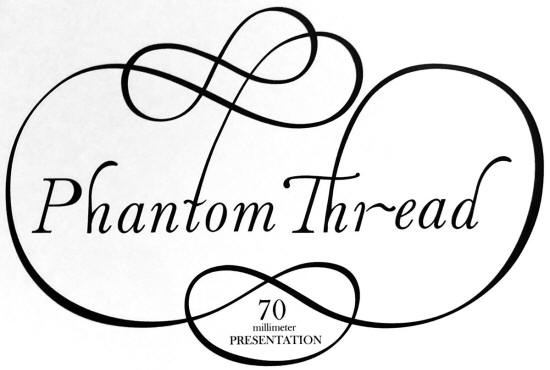Film review: "Phantom Thread" in 70mm |
Read more at in70mm.com The 70mm Newsletter |
| Written and photographed by: Tyler Purcell | Date: 26.12.2017 |
 "Phantom
Thread" costumes on display at the ArcLight, Hollywood, USA "Phantom
Thread" costumes on display at the ArcLight, Hollywood, USAIt’s very rare in this day of poor movies only designed to make money, to see something as elegant and well made as Paul Thomas Anderson’s new movie “The Phantom Thread”. This seemingly simple love story between a self-absorbed dressmaker (Reynolds Woodcock) and yet another model (Alma), has much complexity lying below the surface. As director Paul Thomas Anderson explained in a recent interview; the script is thin, because the story is told through looks. This sort of storytelling works well in a period piece, which this very much is. Anderson came up with the story researching fashion industry mogul Cristóbal Balenciaga. Set in the 1950’s England, Woodcock played by Daniel Day-Lewis, is a self-absorbed career-minded dressmaker, who is seemingly only interested in women for their shape. He’s obsessed with finding the perfect shape to help guide his dressmaking and after he kicks out his previous in-house girl, finds Alma (played by Vicky Krieps) a cafe worker near his sea-side home. He falls madly in love with her body and Alma has nowhere to go, so she’s dragged into his world. At first, she loves being pampered and dressed, but eventually realizes Woodcock is a very difficult and distant person to be around. His obsession with work is nearly constant, which puts their relationship into uneven territory. This is not helped by Woodcock’s sister Cyril (played by Lesley Manville) who lives with him as well. She’s seen these relationships come and go, seemingly dozens of them in recent years. She’s there to protect and manage her brother and rightly so, he needs managing. Alma does truly love Woodcock and tries desperately to save the relationship because she knows deep inside, he loves her too. After many failed attempts, she goes for the jugular and like a Shakespearian play. Her very rash and dangerous thought process, puts them back together again in an unexpected way. Woodcock eventually catches on to her madness, but instead of punishing her, accepts it’s the only thing that will keep them together. |
More in 70mm reading: "Phantom Thread" is released in 70mm P T Anderson's "The Master" in System 65 70mm Blow Up List 2017 - by in70mm.com Panavision and the Resurrecting of Dinosaur Technology The Hateful Eight is a Wonderful Cinematic Experience for the true Cinefile Nolan's "Dunkirk" will feature over 100 minutes of IMAX material Internet link: |
 "Phantom
Thread" show times at the ArcLight, Hollywood, USA "Phantom
Thread" show times at the ArcLight, Hollywood, USAThis wonderful, beautiful and lush story is acted with impeccable precision and love by three brilliant actors, some who’ve already won awards for their performances this year, even though the movie isn’t being released until January. The story goes that Paul Thomas Anderson wrote the story years ago for Daniel Day-Lewis, who is long retired from acting. It was about convincing him to come out of retirement, that was the delay in production. It was Lewis who found the movies leading lady Vicky Krieps, who until this point had not played a leading lady in an American film. The two of them have amazing chemistry, to the point where they seem like old mates from another life. This is one of Daniel Day-Lewis’s best performances of his entire career. It’s incredible seeing him on screen, he is a tour de force and constantly amazes the viewers at every moment. Even in static shots of his face, you can see him thinking, he really is Reynolds Woodcock. Then there is his sister Cyril, what a magnificent performance by Lesley Manville, a British television regular. She is the glue that binds the story and Woodcock’s life together. Since this movie is a period piece, costumes, vehicles, buildings, everything needed to be adjusted to fit the period and there were little to no “touch ups” done in post. The costume design was outstanding, not just the dresses made by Woodcock, but also the normal clothes people wore. You could feel the fabric as it was being worked with, you could smell the rooms and hear the creeks as people walked around. The entire movie was shot on location, both in London and a near-by seaside town. This allowed the production to focus on just a few places, which makes the art direction that much better. This movie is the first time Paul Thomas Anderson worked without a cinematographer. His normal DP Robert Elswit, was unavailable but his normal crew was available. Since all you really need is a vision, great gaffer and camera crew, the role of a DP isn’t AS important. Michael Bauman was credited as the “lighting cameraman” which is incidentally the same credit as Kubrick used on his movies. It’s not easy to shoot a period piece, mostly taking place in a small “practical” (on location) rooms, but the cinematography on this movie was impeccable. Shot in 3 perf 35mm with Kodak Vision 200T and 500T stocks, the movie looks absolutely stunning and fits the period perfectly. Anderson works entirely photo chemically, producing his movies the old way, striking dailies, watching film prints on a daily basis during production and cutting negative. Due to Anderson’s obsession with high quality theatrical distribution, the film is being presented in 4k digital OR as I saw it, 70mm blow up’s from the original camera negative. The print at the Arclight is directly from the negative, which is quite astonishing. There were moments when I shed a tear because of how good film looks when shot properly. Things like dynamic range, the delicious blacks and soft highlights, there is just no other way to put such a beautiful image onto a screen in my opinion. |
|
 Then
there is Johnny Greenwood, or should I call him, the best composer for 2017.
His score is by far, one of the best scores I’ve ever heard, could be one of
the best scores in cinema history. He did this with Anderson’s “There
Will Be Blood” in 2008, but this time he’s outdone himself. Not only did
he reference period music, but also the classics, integrating many themes
from classical composers. The theme can be heard on nonesuch records youtube
page if you so desire to look it up. That piece is only one of a dozen
pieces which lead you to remember the beautiful visuals and storytelling. Then
there is Johnny Greenwood, or should I call him, the best composer for 2017.
His score is by far, one of the best scores I’ve ever heard, could be one of
the best scores in cinema history. He did this with Anderson’s “There
Will Be Blood” in 2008, but this time he’s outdone himself. Not only did
he reference period music, but also the classics, integrating many themes
from classical composers. The theme can be heard on nonesuch records youtube
page if you so desire to look it up. That piece is only one of a dozen
pieces which lead you to remember the beautiful visuals and storytelling.
In retrospect, one has to admit this could Paul Thomas Anderson’s best movie and looking back on the year’s movies, by far the best movie of 2017 in my opinion. It has everything anyone could ever want in a movie, wonderful story, brilliant acting, set on a stage that’s entertaining and provocative. Then you add all the technical accolades and the entire picture is perfect in my mind. As the movie finished and the credits came on, the finishing touch was the photochemical credits, something that nobody does anymore and it just reinforces the artistic beauty of the format. This isn’t just a movie about what’s on screen, but also a swan song to the photochemical process and the beauty that lives within. This is a movie that MUST be seen by any film buff, anyone who cares about the artistry and photochemical process. I can’t wait to see it again. |
|
| Go: back - top - back issues - news index Updated 22-01-25 |
